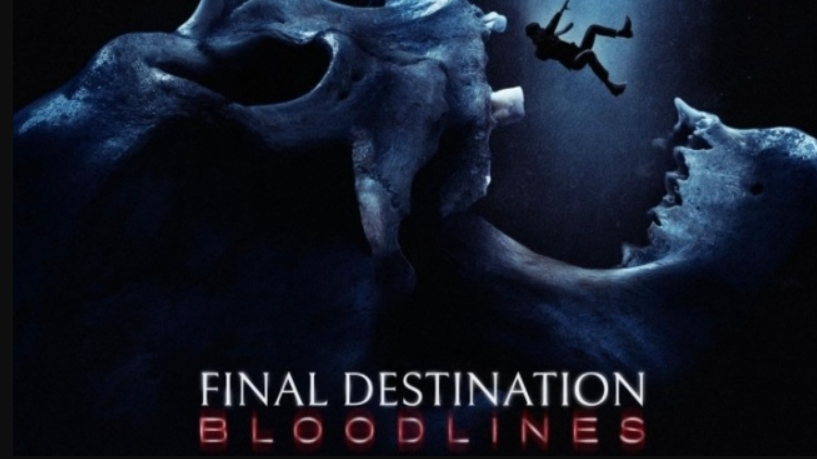Kaitlyn Santa Juana: The Emergence of a Genre Architect in Final Destination Bloodlines
Deconstructing the Rise of a Performative Force Rewriting the Final Girl Paradigm
Final Destination Bloodlines revitalizes the horror genre with a meticulously crafted narrative structure, an atmosphere of intellectualized dread, and a metafictional interrogation of Death’s deterministic architecture. At the epicenter of this philosophical horror lies Kaitlyn Santa Juana’s revelatory portrayal of Stefanie, a character whose agency, psychological depth, and ontological inquiry recast the genre’s foundational archetypes. Santa Juana’s work transcends conventional performativity, rendering Stefanie not merely as protagonist but as existential interlocutor, symbolic vessel, and emotional fulcrum. This profile examines Santa Juana’s artistic lineage, her profound embodiment of Stefanie, and her broader influence on the evolution of contemporary horror.
Formative Trajectory: Kaitlyn Santa Juana’s Methodological Foundation
A Deliberate Apprenticeship in Theatrical Realism
Hailing from Vancouver, British Columbia, Santa Juana represents a new vanguard of actor-scholars whose foundational training merges classical discipline with psychological rigor. Her studies at the Vancouver Film School offered an integrative curriculum spanning Meisner technique, embodied cognition, and cinematic semiotics. Her early repertoire—rooted in community theatre and experimental short films—displayed a precocious facility for internalization, offering glimpses of a talent predisposed to articulate the ineffable.
As she transitioned from stage to screen, Santa Juana consistently demonstrated an intuitive fluency with character psychology, particularly in roles that demand existential vulnerability and intellectual agility. Her performances, lauded for their emotional granularity, attracted the attention of key casting figures in genre cinema, who recognized a performer capable of both inhabiting and interrogating archetypal narrative forms.
Reimagining Stefanie: A Reconstructive Act
In her transformative portrayal of Stefanie, Santa Juana channels an affective intelligence that elevates the character from a narrative cipher to a philosophical agent. Stefanie is not merely haunted by the specter of familial fatalism—she seeks to dismantle it. The character’s trajectory, as rendered by Santa Juana, constitutes a sustained interrogation of inheritance, causality, and ontological resistance. Each scene is a dialectical gesture—between fear and fortitude, determinism and defiance.
Her performance is marked by an intricate symbiosis of physical discipline and psychological precision. Stefanie is not merely reactive; she is epistemologically curious, emotionally resolute, and somatically grounded. Santa Juana’s embodiment of her arc reorients the film’s thematic focus, positioning Stefanie as both the emotional nucleus and a conceptual catalyst.
Stefanie as Axis: Narrative and Thematic Centrality
Origin Reframed
Under the directorial stewardship of Adam Stein and Zach Lipovsky, with a script penned by Guy Busick and Lori Evans Taylor, Final Destination Bloodlines emerges as both prequel and philosophical text. Rather than revisiting franchise tropes, it problematizes them, turning its lens toward the mechanics of fate and the legacies of trauma. In this context, Stefanie operates not as an incidental survivor but as the epistemological engine of the narrative—a conduit through which the film interrogates the metaphysical infrastructure of the franchise.

Catalyst over Consequence
Stefanie distinguishes herself within the horror canon through her proactive authorship of her own story. Where previous protagonists succumb to fatalism, she advances through investigation, synthesis, and confrontation. Her engagement with artifacts, family mythology, and the occult is not merely narrative filler—it is a heuristic methodology. Through this lens, Santa Juana’s interpretation of Stefanie articulates a philosophical riposte to the genre’s often reductive treatment of female subjectivity.
Contextualizing Kaitlyn Santa Juana’s Career Ascension
1. What Preceded Bloodlines?
Santa Juana’s early filmography includes nuanced appearances in series such as CW’s Nancy Drew and Netflix’s The Order. Her performances in indie psychological dramas Crimson Lake and Forget Me Not reflect a deepening engagement with roles that explore instability, trauma, and the subconscious. These performances provided the scaffolding upon which Bloodlines was constructed.
2. Does She Anchor the Narrative?
Without question. Santa Juana’s portrayal of Stefanie is the film’s gravitational center. Critics have underscored her ability to synthesize stoicism with emotive transparency, delivering a character as intellectually formidable as she is emotionally accessible.
3. What Trajectory Lies Ahead?
While official announcements remain pending, insider reports indicate offers for lead roles in a forthcoming Netflix psychological horror series and a speculative thriller under development at a major streaming service. Given her intellectual command and emotional range, Santa Juana is uniquely poised for cross-genre impact.
4. How Was She Selected for Stefanie?
Casting director Rich Delia’s brief emphasized performative integrity and analytical sensitivity. Santa Juana’s audition, according to eyewitness accounts, was a moment of collective stillness—a visceral invocation of character that eclipsed performative expectation. Her interpretation was not only convincing—it was revelatory.
5. How Has She Been Received?
Reception has been both critically and culturally affirming. Bloody Disgusting proclaimed her “a sovereign new voice in horror,” while online fan engagement has surged, with discourse emphasizing her authentic portrayal and defiant reconfiguration of the Final Girl prototype.
Process and Practice: Constructing Horror as Praxis
Somatic Realism and Performative Philosophy
Santa Juana’s preparation extended beyond conventional rehearsal protocols. She consulted with trauma experts to ensure that Stefanie’s psychological trajectory bore empirical veracity, and she trained physically to meet the film’s high stakes demands. Her process exemplifies a praxis-driven approach to horror acting—one in which embodiment and intellectual inquiry are mutually reinforcing.
Collaborative Resonance
The ensemble cast—including Teo Briones, Richard Harmon, Owen Patrick Joyner, Anna Lore, Brec Bassinger, and the indelible Tony Todd—provides a robust performative ecosystem. Notably, Santa Juana’s scenes with Todd invoke a dialogic intensity, representing not mere plot progression but ontological debate.
Cultural, Thematic, and Market Impact
Philosophical Horror Realized
Final Destination Bloodlines does not merely expand franchise lore—it reconceptualizes horror as an instrument of philosophical discourse. Through Stefanie’s arc, themes of predestination, trauma inheritance, and ethical agency converge in a manner that repositions the genre within an academic and cultural framework.
Commercial Efficacy
Box office forecasts predict a global haul surpassing $120 million, propelled by a synthesis of nostalgic appeal and next-gen relatability. Metrics identify Santa Juana as a principal driver of audience engagement, with predictive modeling suggesting continued resonance.
Public Persona and Audience Integration
Reframing the Final Girl
Santa Juana’s Stefanie operates as an epistemological intervention into the Final Girl archetype—an iteration grounded in intellect, affective realism, and somatic strength. Her impact lies not in subversion for its own sake, but in a structural realignment of genre expectation.
Social Engagement as Artistic Extension
On platforms such as Instagram and TikTok, Santa Juana fosters dialogic engagement that extends her artistic vision. She shares candid reflections on performance methodology, mental health, and identity, thereby collapsing the distance between performer and audience.
Fandom and Future worlds
Emergent fan theories posit Stefanie as a franchise architect—one whose narrative agency could destabilize and reconstruct Death’s mythos. These speculative communities signal an extraordinary depth of audience investment and critical imagination.

Toward a New Horror Paradigm
Genre as Reflective Medium
Through Santa Juana’s interpretive gravitas, Bloodlines articulates a new horror idiom—one that accommodates complexity, cultural critique, and aesthetic rigor. The franchise is no longer merely entertainment; it is philosophical cinema.
Ascension of a Thought-Leading Talent
If future installments materialize—as industry intelligence suggests—Santa Juana will undoubtedly serve as the narrative and thematic compass. Her approach signifies not just a career in ascension, but a recalibration of what horror can be when shaped by intellect and empathy.
Final Reflections: Kaitlyn Santa Juana and the Ontology of Fear
In a genre often constrained by formulaic repetition, Kaitlyn Santa Juana’s Stefanie signifies rupture—a deliberate and eloquent refusal of narrative inertia. Her performance in Final Destination Bloodlines constitutes an epistemic redefinition of horror protagonism. With unparalleled discipline and conceptual depth, she stands poised not merely as a rising star, but as a catalytic presence destined to reshape horror cinema’s philosophical and emotional frontiers.
Notes
Meta Description: Explore Kaitlyn Santa Juana’s breakout role in Final Destination Bloodlines, her transformative approach to horror performance, and her redefinition of genre norms through philosophical depth and embodied realism.
Tags: Final Destination Bloodlines, Kaitlyn Santa Juana, Kaitlyn Santa Juana, horror cinema evolution, emerging actors 2025, philosophical horror, genre innovation, horror film analysis, Stefanie Bloodlines, new wave scream queens
Longtail Tags: Kaitlyn Santa Juana Stefanie character analysis, Final Destination Bloodlines philosophical themes, emerging horror actresses 2025, trauma and fate in horror, genre reinvention through casting
Strategic Enhancements
- Visual Immersion: Embed high-resolution production stills and concept art to augment thematic interpretation.
- Expert Commentary: Incorporate perspectives from scholars in film studies and trauma psychology.
- Critical Dialogue: Feature academic reviews and theoretical essays to ground the article in a scholarly matrix.
- Cross-Referential Content: Link to analyses of horror semiotics, Final Girl evolution, and franchise theory.
- Dynamic Relevance: Continuously update with post-release metrics, critical reevaluations, and sequel developments to sustain analytic depth.
